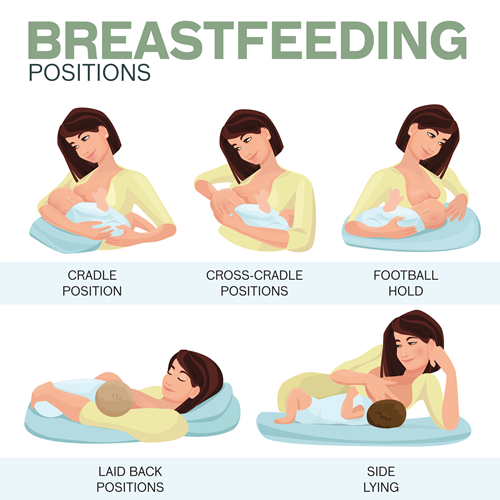If you choose to breastfeed your newborn, there are bound to be questions. However, with the right information and support, you can develop the breastfeeding techniques and strategies that work best for you and your baby.
To help you along your journey, we spoke with Megan Dunn, a board-certified lactation consultant at Atrium Health and Atrium Health Levine Children’s. Here’s what she says are the most common breastfeeding concerns new mothers have – and the best solutions to keep your baby (and yourself) happy and healthy.
Tips for facing 7 common breastfeeding concerns
Megan Dunn, IBCLC
1) It hurts to breastfeed.
Breastfeeding shouldn’t be painful. When a mother’s milk increases in volume 3 or 4 days postpartum, moms may notice sore and/or tender nipples. Since new babies feed every few hours, this discomfort may worsen quickly. If the cause of nipple pain isn’t addressed, some moms may even suffer cracked, bleeding or blistered nipples.
Here are a few tips to potentially combat this issue:
- Check your baby’s latch.
The most common cause of breastfeeding pain is a shallow latch. Your baby's latch should draw your nipple and much of your areola (the darker region around the nipple) into the baby’s mouth. Latching shallowly to the nipple causes a mother to experience pain. Achieving a deeper latch by correcting positioning can increase comfort and help the baby remove more milk from the breast.
To be sure that your baby’s mouth and body are positioned correctly, I suggest you see an Atrium Health lactation consultant or breastfeeding specialist. Our experts can check for all latching issues, including taking a look inside your baby’s mouth to see if there is a physical problem.
- Try different positions.
To take pressure off the most sensitive/painful breast areas, I encourage my patients to nurse in a few different positions to learn what works and feels best for the mother and baby. Here are a few examples.

- Keep your nipples clean and dry.
After feeding, it’s important to remove any debris that could lead to infection. For this, I suggest rinsing your nipples with warm water or wiping them with a water-moistened cotton ball after nursing. Wash your breasts and nipples with a mild cleanser once daily when you bathe. Frequent use of soaps can cause the skin to become dry.
Infection flourishes in damp conditions, so try your best to air-dry your nipples or dab them dry with a very clean, soft muslin or flannel cloth.
I tell my patients to use either disposable or washable nursing pads to absorb any milk leakage, and to remember to change them regularly.
- Soothe your nipples.
Many of my patients experience dry or sore skin, especially around the nipples when they first start breastfeeding. To relieve soreness and/or dry skin, apply coconut oil or ultra-pure lanolin ointment (don’t use lanolin if you are allergic to wool), or gently apply a few drops of your breast milk to tender nipple areas. There’s no need to remove it before your next feed. Another thing you can try is refrigerated hydrogel pads. These nipple dressings are cool and provide instant pain relief, but be sure to wash them with soap and warm water and allow them to dry completely between each use.
- Be patient.
From what I have seen with my patients, soreness often lessens or goes away as the body adjusts to breastfeeding. There’s no need to worry immediately – it usually just takes time.
However, if the pain does not subside after a few days, you should consult an Atrium Health lactation consultant, breastfeeding specialist or other healthcare professional. Ongoing soreness or pain may be a sign of an infection requiring medication.
2) The baby is not latching correctly.
At times, a newborn may struggle to find the right latch. This may occur for a variety of reasons, whether you both need more time to get coordinated, the baby was born prematurely, or you have flat or inverted nipples.
If any of these are true for you, here are a few things you can try:
- Adjusting your hold.
To feed properly, your newborn needs to feel supported, comfortable and able to breathe. Try your best not to hold or push your baby’s head as this can affect their experience. A laid-back, baby-led feeding style allows your child to use their innate reflexes and latch on more easily.
- Making minor changes over time.
Taking your baby on and off your breast can create frustration for both of you. Instead, ensure that your newborn is well-positioned and comfortable. Keep their body and bottom close to you, support them across their shoulder girth, and hold them firmly so they feel secure. Your newborn’s head should rest on your wrist so it can tilt back slightly and provide more space for the baby to breathe.
- Using nipple shields.
If your baby is not latching on, nipple shields may provide them a larger, firmer target to feed from. However, nipple shields should be used as a short-term, not a long-term, solution. And you should follow up with your baby’s pediatrician or your lactation consultant to ensure that your baby is feeding effectively and gaining weight appropriately.
- Getting support.
If your baby is not latching correctly, I suggest seeking out an Atrium Health lactation consultant or breastfeeding specialist. Our experts will help diagnose the cause of your problem and develop a plan with you to solve it.
3) There isn’t enough milk.
In the initial days postpartum, some mothers are concerned that they’re not making as much milk as expected. However, I tell them not to be concerned. That’s because hormonal changes that trigger a mother’s milk production take place slowly. In fact, milk production often doesn’t peak until around day 3 or 4. This is usually not a problem since your baby’s stomach is small at first, and they feed frequently.
However, during the initial days postpartum, if your baby is losing more weight than expected, producing too few wet or dirty diapers, or showing signs of dehydration, these could indicate a milk supply problem. If any of these occur with your newborn, I suggest:
- Feeding on demand.
If possible, avoid a scheduled feeding pattern. In the first week postpartum, your newborn will want to feed at least every 1 to 3 hours throughout the day and night. This frequency will help boost your milk production.
- Building your milk supply.
If your baby is feeding often but still not gaining weight, our lactation consultants or breastfeeding specialists may recommend pumping to increase your milk supply.
- Taking good care of yourself.
While it’s not always easy with newborns, try to get rest, eat well and accept help whenever possible with chores and/or other children’s activities. This will make it easier to focus on breastfeeding.
- Seeking help.
Our lactation consultants and healthcare professionals will be able to assess if you have a milk supply issue. The sooner you get help, the better.
4) My breasts are full and hard.
This is something I often hear from new mothers. When a mother’s milk comes in, her breasts will become fuller and firmer. If your newborn feeds well and frequently, this should resolve on its own. However, some women’s breasts become engorged, rock hard, and feel tender, uncomfortable and even painful. Although this is only temporary, engorgement can make it difficult for your baby to latch as your nipples may become flattened.
If your breasts become engorged, here’s what you can do to maintain healthy breastfeeding with your baby:
- Feed your newborn often.
Aim to feed at least 8 to 12 times every 24 hours. Listen for swallowing – sustained rhythmic sucking and audible swallowing are signs that your baby is feeding well and removing milk from your breasts.
- Ask for guidance.
If breast engorgement lasts for more than 48 hours, you have a fever, or your newborn cannot feed due to your engorgement, seek a healthcare professional for help.
5) I’m making too much milk.
This is another common concern of new mothers. Sometimes, for the first few weeks of breastfeeding, you may see a temporary oversupply of milk. This usually resolves on its own. However, until then, your breasts may feel tender and painful, and you may be leaking a good deal of milk. You may also notice that your baby is coughing and/or spluttering with the force of your feed, spitting up post-feed, or passing explosive, frothy and greenish poop.
If you’re concerned you’re overproducing, here are a few things you can try:
- Release before feeding.
Use your hand to express a small amount of milk before each feed. This may reduce the force of your let-down.
- Let your baby control the flow.
A laid-back feeding position may allow your newborn to better control the flow of milk. Another option is the cradle position, holding your baby across their shoulders with their head tilted back and resting on your wrist. Your newborn’s body should be resting on yours, sloping down diagonally.
- Take it slow.
Be gentle and patient when feeding your newborn. Allow them to rest and digest your milk, both during and after each feed. Moving your baby around too much or too quickly may increase spitting up. As they grow, their digestive systems become more mature, and they will learn how to cope with the flow.
- Soak the surge.
If your baby appears overwhelmed when your milk starts to flow, use a towel or muslin cloth to soak feeding overflow. You may also wear a milk collection shell on your other breast to catch any leaks.
- Get help.
If you are still overproducing milk after several weeks of feeding, seek advice from an Atrium Health lactation consultant or breastfeeding specialist. Our experts will assess your milk production and may advise one-sided feeding or block feeding to reduce your supply.
6) My nipples are pink and painful between feedings, and I feel shooting pains in my breasts.
If you are experiencing these symptoms, you should consult your doctor, midwife or lactation consultant. These may be symptoms of thrush, an infection stemming from a yeast organism known as Candida albicans. Thrush could be affecting both you and your child. As babies sometimes become infected in their mouth or bottom, often mothers and children will both need treatment.
7) One area of my breast is super tender.
In some cases, a sensitive area in one of your breasts may indicate a plugged duct. While there are several reasons this may occur, I always tell my patients that the solution is the same – get milk flowing to this area. When feeding, try to position your baby so their chin points toward the tender spot and massage this section while the newborn feeds. Apply heat between feedings. If tenderness persists, ask your healthcare provider about ultrasound treatments. Plugged ducts that aren’t resolved, as well as cracked and damaged nipples, can sometimes turn into a breast infection called mastitis. Notify your OB or midwife if you develop a fever or redness that’s spreading on your breasts.
Breastfeeding takes time, practice and support. At Atrium Health and Atrium Health Levine Children’s, our board-certified lactation consultants are here for the journey, providing you and your baby with support and guidance at every step. They can meet with you to discuss feeding difficulties and concerns and get you and your child on the path to proper health. To see available support options, visit AtriumHealth.org/Maternity.
Looking for more resources and information for moms-to-be and women? Visit our Women’s Resource Hub.



